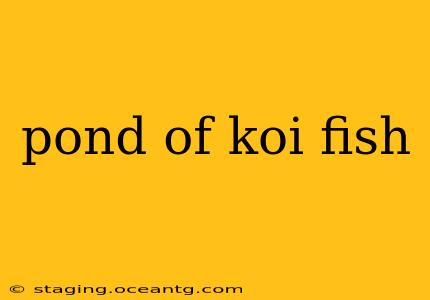Koi ponds are more than just water features; they're living, breathing ecosystems that bring beauty and serenity to any landscape. Creating and maintaining a healthy koi pond requires careful planning and consistent effort, but the rewards – watching these elegant fish gracefully glide through your backyard – are immeasurable. This comprehensive guide will walk you through everything you need to know, from initial planning to ongoing maintenance.
What size pond do I need for koi fish?
The size of your pond is crucial for the health and well-being of your koi. As a general rule, you should aim for at least 1,000 gallons of water for a small group of koi. Larger ponds, 2,000 gallons or more, are ideal, especially if you plan on keeping several fish or larger koi. Remember, koi grow significantly over their lifespan, so planning for future growth is essential. Insufficient space leads to overcrowding, stress, and increased susceptibility to disease.
How deep should a koi pond be?
Depth provides refuge from predators and temperature fluctuations. A minimum depth of four feet is recommended. This allows your koi to escape extreme heat during summer and provides a degree of insulation during winter months. Deeper ponds also help maintain a more stable water temperature, crucial for their overall health.
What kind of filter do I need for a koi pond?
Filtration is the backbone of a healthy koi pond. You'll need a robust filtration system capable of handling the bioload produced by your fish and the pond's organic matter. Consider the size of your pond and the number of koi when choosing a filter. Options range from simple bottom drain systems to more complex multi-stage filtration systems incorporating mechanical, biological, and ultraviolet (UV) sterilization. A well-functioning filter keeps the water clear and prevents the build-up of harmful toxins.
How much does it cost to build a koi pond?
The cost of building a koi pond varies greatly depending on several factors, including the size, materials, features (like waterfalls or landscaping), and whether you hire a professional or undertake the project yourself. Expect costs ranging from a few hundred dollars for a smaller, simpler pond to tens of thousands of dollars for large, elaborate installations. Consider budgeting for ongoing maintenance expenses as well, including filter media replacement, water testing kits, and potential veterinary care.
What plants are good for a koi pond?
Adding aquatic plants to your pond is beneficial for several reasons. They provide oxygen, help absorb excess nutrients, offer shelter for your koi, and add aesthetic appeal. Oxygenating plants like hornwort and water lilies are excellent choices. Marginal plants, which grow along the pond's edges, add beauty and biodiversity to the environment. Be sure to research the specific needs of each plant to ensure they thrive in your pond's conditions. Avoid plants that are toxic to koi.
How do I keep my koi pond clean?
Regular maintenance is critical for a healthy koi pond. This includes:
- Regular water changes: Partial water changes help remove excess waste and maintain water quality. The frequency depends on your pond's size and the number of fish.
- Skimming the surface: Removing leaves and debris from the water's surface prevents them from decomposing and contributing to pollution.
- Cleaning the filter: Regularly cleaning or replacing filter media maintains filter efficiency and prevents clogs.
- Testing water parameters: Regularly test the water for ammonia, nitrite, nitrate, and pH levels to ensure they are within acceptable ranges.
By diligently performing these tasks, you’ll maintain a healthy and thriving environment for your koi.
What do I feed my koi fish?
Feeding your koi a balanced diet is crucial. High-quality koi food formulated with the right nutrients is essential for their growth, color enhancement, and overall health. Avoid overfeeding, as this can pollute the water and contribute to algae growth. Feed your koi in moderation, adjusting the amount based on their size and water temperature.
Creating a thriving koi pond is a rewarding journey. By carefully considering these factors and committing to regular maintenance, you can create a beautiful and peaceful environment where your koi will flourish for years to come. Remember, patience and observation are key to understanding the unique needs of your pond and its inhabitants.
